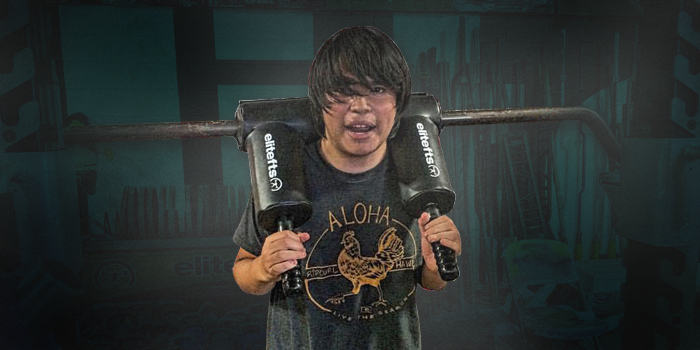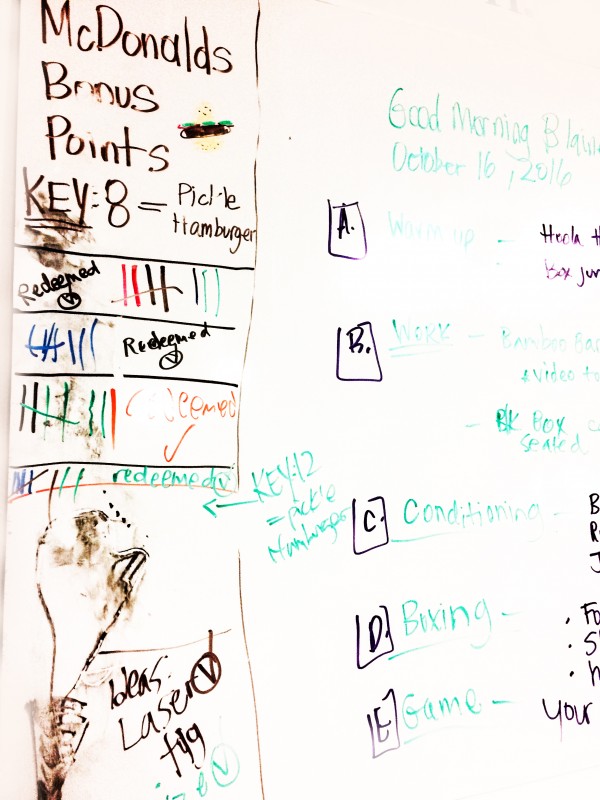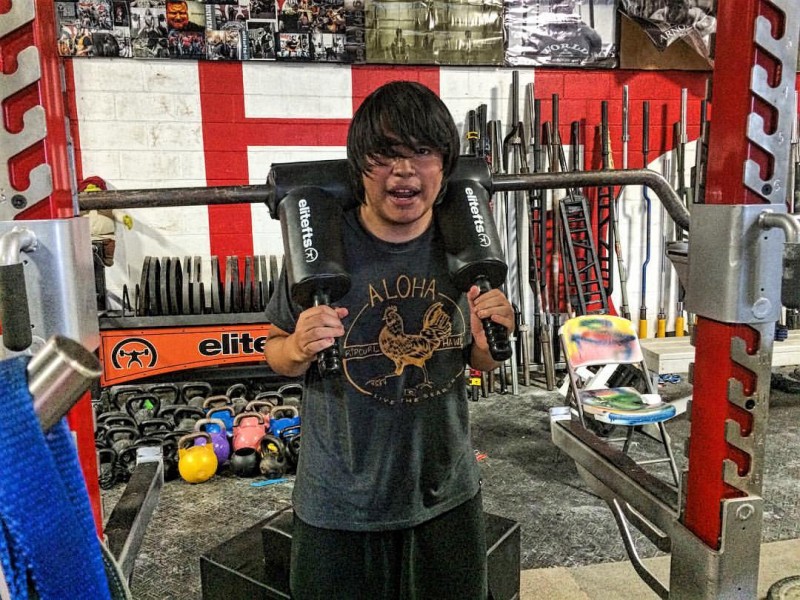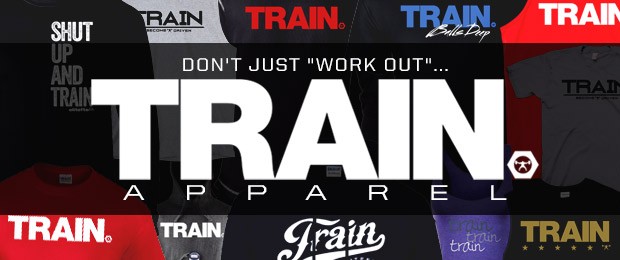
It seems most appropriate to pause the Social Integration with Movement and Strength series and interject with Blaine’s progress since competing in his first 5K. Dave simplifies what I’ll say in a couple thousands of words in five, but I’d like to expand on the many milestones we’re experiencing and try to give some explanation as to why.
After committing our efforts to competing in our first 5K, witnessing Blaine run with his head held high with a smile from ear to ear, and reaching our goal of crossing the finish line in less than 60 minutes, I was left with a question. Now what?
RELATED: Zoo RunRun — Blaine Crosses the Finish Line in His First 5K
Erasing the zoo schedule from the dry-erase board that served us for a 14-week prep was unsettling. Where do we go from here? How will training change? Do we need another competition to aim for? Does Blaine need a break from training?
The week after our run, training resumed per usual by dropping our modifier (we were no longer training for a race).
Where our training has gone, is miraculous.
In candid fashion, transparency between programming and performance are revealed in each and every milestone. Answering the questions above, here are the things we’re experiencing in the gym since May (back story per milestone included) with a vision of where our training is taking us.
Sets and Reps
Multiple sets of one exercise with rest, progressing in weight each set, is pretty typical for most lifters, but for us, not so much. Blaine wanted nothing to do with multiple sets, therefore the rest aspect and progression in weight could not be factored in within a single training session. Preparing for the race, we placed great emphasis on getting our legs stronger, so multiple sets and reps with rest between became part of our plan. Naturally, Blaine accepted this new type of training once it had a direct effect on performance. This type of setup has moved from leg training to every exercise we attempt. Coincidentally, our training volume and time spent lifting weights has dramatically increased within a single training session.
Squat, Bench, and Deadlift
There was a time when obstacle courses held our attention for a bigger part of a training session. Through non-stop action, Blaine excelled in the elements of creation, rule mandating and turning work into play. It was a great opportunity to present squatting, benching and deadlifting movements into the mix, along with running, jumping, crawling, pulling, balancing, and aiming exercises using a variety of equipment — exercise and equipment use that otherwise would be dismissed. If this was the layout that motivated him to move, I was all for it.
For years, singling out the squat, bench, or deadlift was off our radar — we just weren’t there. Fast forward to 5K prep, WORK became a new section in our schedule. This is where it became appropriate to slow down and focus on a particular lift, and channel our energy to perform a lift with good form. Our motivation for good form: use weight and increase the weight week to week. After all, we needed to get stronger for competition. WORK remains on our schedule with the same intent. Exercise choice and interest moves from the squat, to the bench press, to the deadlift. Last week I placed a mini game in work and Blaine erased it. He said we can’t play a game in WORK. We have to work in WORK.
Acceptance of Weakness
There’s no way to avoid facing weakness when performing the three lifts. It doesn’t matter where you sit on the continuum between novice and pro; there’s always a weakness, and there’s always something to improve upon. If strength is our goal, we have no choice but to accept our weaknesses, tackle them until they’re no longer weaknesses, and then search for more weaknesses. When strength wasn’t clearly defined for Blaine as it is now, weakness was interpreted as inferiority. So if he knew his left leg was weaker than his right, he didn’t want to use his left leg. In arm wrestling, he didn’t want to wrestle with his left arm because he knew there was a chance he’d lose. If an exercise was challenging for him, he wanted to move onto something else. Now, between sets we converse about the lift and its multiple parts. We cue a part, practice the lift, and then we find other exercises to build up our weaknesses. Blaine is even taking cues from Dave.
Let’s go back to how it all began. Did I know how to train his needs? Now I know the answer is NO, but I knew enough to be close and not hurt him. He wanted NONE of it. He didn’t want to train with me at all, in no way, and still wouldn’t today if it were just us. For him to accept the cue and apply it may not seem like very much but it’s really big because it wasn’t even forced or asked for, it was just me being me in the gym. — Dave Tate
Dave gave Blaine ONE THING to work on and this one thing was attainable. The chance of Blaine accepting another cue from Dave is GREAT. You can imagine Blaine’s response if Dave had attempted to reconstruct the entire setup. I do feel, however, this will eventually be the case.
Motivators, Reframed
We have a Pickle Hamburger Tally on the dry erase board that sits to the left of our daily training schedule. Eight tally marks earn Blaine a McDonald’s hamburger. Dave presented this idea to Blaine a few months ago as something Blaine can work towards and earn a tally by choosing one exercise each workout where his effort is an 8-10 (all out effort). Blaine loved the idea, as this motivator reinforces favorable behavior in the school setting.
For a few weeks, we earned tally marks following the guidelines above and then the rules slightly bent. In Blaine’s initial introduction to landmine box squats, he’d plop onto the box with minimal effort. Mid-set he questioned, “If I do more reps will I earn a tally?” I told him I loved the idea but so far none of his reps counted. This was a solid way for me to explain that sloppy reps are not what we’re after. His reps would only count if his feet stayed flat on the floor, if he kept his stomach tight, and if he eased onto the box pretending that eggs would crack and yokes would ooze if we plopped. Instantly, Blaine was able to keep his feet flat, stay tight, and ease onto the box. Imagine that! A few weeks in with motivators reframed, “effort”, “extra work”, “challenging sets”, and “intensity” all have newfound meaning. He’s no longer moving weight to move weight or giving empty effort to earn a hamburger. Instead, the motivation is attached to a purpose and an ideal we’re reaching for. The standard of earning a burger through eight tallies has been raised to twelve in ten short weeks.
Under the Bar
I can’t help but take us back to October of 2013, where squats were stamped as pain and struggle. It’s inclusion in any sense triggered a meltdown that immobilized Blaine, Dave, and myself. In 2016 while prepping for the race, leg training became multi-dimensional. We were looking for new ways to train our legs. Again, we had a purpose for these movements, so each week we were trying something new and carrying over learned skills to each variation. Leg work included: sprints, relay races, box jumps, back extension, leg press, hack squat, hack squat to a box, med ball squats, prowler pushes, sled drags, and barbell landmine squats. The need for a challenge after the race continued. And then it was time to get under the bar. Granted, years prepared us for this moment; it was naturally the next progression to our training.
Milestones have been met with some of the biggest watching him squat. As someone who is very serious in the gym, I never thought for one second that the strain, pain, blown out eyes, bloody noses, and red faces when squatting heavy would make a child think the squat was something to avoid. I mean, this is AWESOME, right? In this case, it did just that. It created fear and a dislike of squatting for him. It took time...but he now squats. — Dave Tate
Blaine read the schedule aloud, “Safety Squat Bar Box Squats in Rack.” There was a pause and then a bleep, “I can’t squat.” Without a doubt, I reminded him of all the squat variations and leg work we’ve accomplished up to this point. Something clicked as he reflected on what he accomplished for months on months. Any fear vanished and he stood under the bar, unracked, walked out, squatted, and stood back up, for reps, and for multiple sets.
Social Change
Those that surround us on the weekends have grown accustomed to Blaine’s training. They know those that give Blaine the slightest bits of attention have a great chance of earning a nickname and are asked to play a game or compete in a challenge. Powerlifters stop in between sets to join us in obstacle courses, jump rope, parachute play, tug of war, foam roller jousting, boxing…heck, we’ve had one guy come to the gym to train solely with us! Although the former remains intact, Blaine is renewing and developing his identity through a few modified associations:
Courteous. Rather than startling a peer by getting too close and squeezing, punching, pinching, and/or slapping (playfully), Blaine is using his words or hand on the shoulder to start a conversation.
Helpful. If his brother joins us for a session, Blaine’s role changes as the expert. And with that, he’s no longer the annoyed brother but a professional, teaching form and keeping a watchful eye.
Worker. Formally the jokester, there have been multiple instances that after a session someone compliments Blaine on his effort via form, attitude, or strength.
Brings us back to 5K prep territory... Blaine's idea to do work at the lake instead of the stadium. Seemed like a perfect opportunity to propose the idea of competing at the #zoorun annually (next spring). #noprotest #chubbyfingerscrossed #autism #METAL A video posted by Sheena Leedham (@sheenaleedham) on
Competition serves as a privileged, single snapshot of the culminating weeks, months, and years of consistently showing up, doing work, and facing challenge. It acknowledges where we came from, magnifies what we’re doing, and creates a vivid vision of where we’re going.
Oh and funneling this article down into Dave’s simplified version: “He’s slowly becoming a meathead.” He’s even a member of the Bob Evans, pre-training bloat, Sunday breakfast club.
Stay tuned.












Thanks for the message. Like you, Dave's goal for Blaine early on was for Blaine to have consistent movement that would be perceived as fun. Long term, he wanted Blaine to have the gym be a healthy place to work off aggression,anxiousness, etc. Those were the parameters I was given from Dave along with his trust to create the programming as I felt fit. There is a lot of trial and error, but for you it's gauging where the child is, today. As much as you want to look forward to 5 years down the road, be present and be in tune with where he's today. What interests your children? When do they experience the most joy? How can you combine movement with their interests? Because you're focused on the now, small improvements and efforts will be celebrated by you and the children --- This has always been my approach and then once consistency takes place then the programming naturally sophisticates. At first Blaine and I worked for 30 minutes weekly, then for 60 minutes weekly, now we're consistently at 90 minutes weekly. As this article outlines, we started with obstacles courses (this is where his interest was and where I could place the fundamentals). Getting under the bar was never Dave's goal or mine --
This article outlines my observations and then how I created a schedule for weekly sessions: https://www.elitefts.com/education/coaching-education/iron-insights-creating-the-schedule/.
Let me know if this helps at all. I'd be happy to continue to help. Thanks,
I was looking for a motivational article on powerlifting, and boy did I find it!
Thank you for filling my cup today.